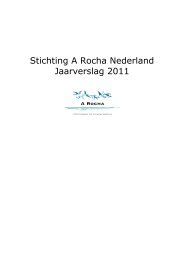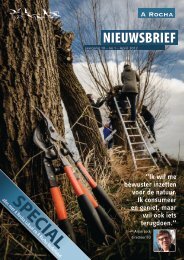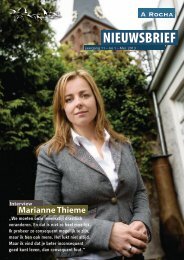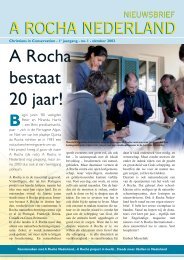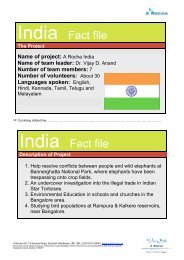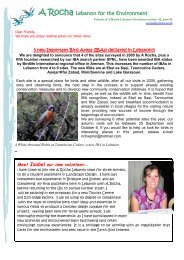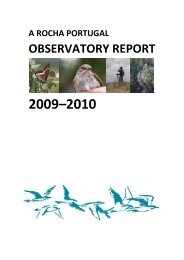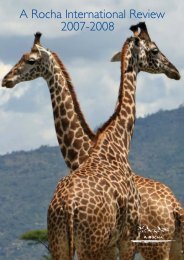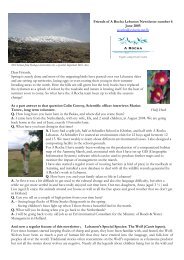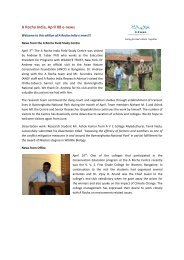Macro-moths of the Algarve - A Rocha
Macro-moths of the Algarve - A Rocha
Macro-moths of the Algarve - A Rocha
You also want an ePaper? Increase the reach of your titles
YUMPU automatically turns print PDFs into web optimized ePapers that Google loves.
Observing <strong>moths</strong><br />
This publication may be reproduced without permission <strong>of</strong> <strong>the</strong> authors, all copies<br />
distributed must be provided free <strong>of</strong> charge.<br />
Contact A <strong>Rocha</strong> Portugal for more information borboletas.noturnas@arocha.org<br />
5<br />
It takes relatively little effort to detect a good number <strong>of</strong> <strong>moths</strong> in your own backyard. The easiest way to do so<br />
is by searching for day-active <strong>moths</strong> during daylight hours, or by using a torch in <strong>the</strong> evening and catching<br />
flying individuals with a net. These and o<strong>the</strong>r techniques are fully described on www.butterfly-conservation.org<br />
(see: discover more about <strong>moths</strong>), or in <strong>the</strong> literature referred to earlier.<br />
Using a light trap is by far <strong>the</strong> most efficient technique to observe a large number <strong>of</strong> <strong>moths</strong> at once. The trap<br />
can be lit throughout <strong>the</strong> night and <strong>the</strong>n <strong>moths</strong> can be identified in <strong>the</strong> early morning. The trapping success<br />
depends on <strong>the</strong> wea<strong>the</strong>r, <strong>the</strong> location, <strong>the</strong> trap type, <strong>the</strong> influence <strong>of</strong> <strong>the</strong> moon and artificial light sources, etc...<br />
In <strong>the</strong> <strong>Algarve</strong>, trapping can take place all year round, with <strong>the</strong> highest number <strong>of</strong> <strong>moths</strong> caught in <strong>the</strong> spring<br />
and autumn months.<br />
If you are interested to making a moth trap, www.atropos.info (garden <strong>moths</strong>) <strong>of</strong>fers a good outline plan to<br />
build your own Skinner trap. To illuminate it, you need a 125W mercury vapour light bulb and <strong>the</strong><br />
accompanying light ballast. Both can be bought in a local electric store or purchased online.<br />
By entering your moth records on websites such as www.biodiversity4all.org we can gain better insight into<br />
<strong>the</strong> flight patterns, habitat preferences and range <strong>of</strong> <strong>moths</strong> in <strong>the</strong> <strong>Algarve</strong>. This website is linked to Observado<br />
which records worldwide nature observations.<br />
Acknowledgements<br />
This work has been coordinated by A <strong>Rocha</strong> Portugal and it would not have been produced without <strong>the</strong><br />
enthusiasm <strong>of</strong> Paula Banza, and <strong>the</strong> hard work <strong>of</strong> many volunteers who assisted in <strong>the</strong> A <strong>Rocha</strong> study centre.<br />
I’m very thankful for <strong>the</strong> kind contributions from all photographers listed in <strong>the</strong> Photo credits. Photographers<br />
are credited using <strong>the</strong>ir initials underneath each photograph.<br />
Grateful thanks to Martin Corley for his valuable data and for checking over <strong>the</strong> images for any identification<br />
errors. I am also indebted to Es<strong>the</strong>r Pawley for editing <strong>the</strong> text, this has been very much appreciated.<br />
It is my hope that this guide can be as complete as possible, <strong>the</strong>refore I urge anyone who is willing to <strong>of</strong>fer<br />
additional information or photographs to please contact A <strong>Rocha</strong> Portugal. (borboletas.noturnas@arocha.org)<br />
Bert Van der Auwermeulen<br />
Photo credits ©<br />
AR: A <strong>Rocha</strong> Portugal<br />
AI: Andres Ivorra (www.almerinatura.com)<br />
AS: Albano Soares<br />
DM: Daniel Morel<br />
DW: Dave Wilton<br />
EM: Eduardo Marabuto (www.lusoborboletas.org)<br />
FP: Franz Pühringer (www.sesiidae.net/sesiidae.htm)<br />
FR: Fernando Romão<br />
IM: Isidro Martínez<br />
JW: Jaroslaw Wenta<br />
LF: Luke Faluke<br />
MD: Mike Dale<br />
MG: Mat<strong>the</strong>w Gandy (www.lepidopteragallery.org)<br />
MiR: Mick Richardson<br />
MoR Monika Reinhardt<br />
MM: Marek Miłkowski<br />
NM: Nick Montegriffo<br />
Pa: Pathpiva (http://pathpiva.wifeo.com)<br />
PP: Pedro Pires (www.lusoborboletas.org)<br />
RP: Raniero Panfili<br />
RW: Robert Woods<br />
TF: Teresa Farino<br />
VJ: Valter Jacinto<br />
YML: Yeray Monasterio León (Asociación Zerynthia)<br />
WS: Walter Schön<br />
WW: Wolfgang Wagner (www.pyrgus.de)




